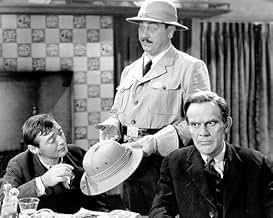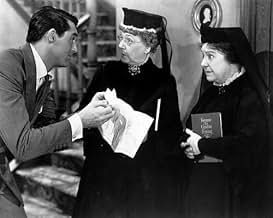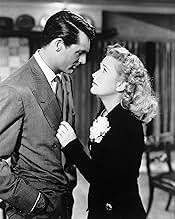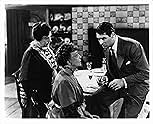Un auteur de livres sur la futilité du mariage met sa réputation en péril après il décide de se marier. Les choses se compliquent encore quand il apprend le jour de son mariage que ses tante... Tout lireUn auteur de livres sur la futilité du mariage met sa réputation en péril après il décide de se marier. Les choses se compliquent encore quand il apprend le jour de son mariage que ses tantes célibataires sont des assassins en série.Un auteur de livres sur la futilité du mariage met sa réputation en péril après il décide de se marier. Les choses se compliquent encore quand il apprend le jour de son mariage que ses tantes célibataires sont des assassins en série.
- Réalisation
- Scénario
- Casting principal
- Récompenses
- 4 victoires et 1 nomination au total
Avis à la une
Arsenic and Old Lace was running on Broadway at the time and authors Howard Lindsay and Russell Crouse had sold the film rights to Warner Brothers. Capra negotiated a deal with Jack Warner for a percentage and told him how he would do the film on the cheap, but not cut production values. Years of experience at Columbia had taught him how. The property was perfect since 90% of it is on one set, the Brewster living room.
So the shooting was for four weeks and a big percentage of the budget was spent on getting a name star for guaranteed box office, that of course being Cary Grant. Of course this being 1941 the shooting was interrupted briefly by the actual attack on Pearl Harbor. But the film wrapped up quickly and was not released to the public until 1944 after the show on Broadway closed. It was however shown to troops overseas as were several other Hollywood films before they reached the domestic market.
Of course with a Capra selected cast the film was a great triumph. Only Jean Adair and Josephine Hull as the Brewster sisters and John Alexander as "Theodore Roosevelt" Brewster repeated their Broadway roles. Capra had insisted on that.
I don't think Cary Grant was ever more frantic in his film career than in Arsenic and Old Lace. He's one bundle of perpetual motion as Mortimer Brewster theater critic and member of a family where insanity doesn't just run, it gallops. He's got two daffy old spinster aunts who poison lonely old men to cure their loneliness, a brother who thinks he's Teddy Roosevelt, and another brother who is a homicidal maniac. Quite a family tree. Grant's performance is so good, you can see the fevered workings of his mind in his facial expressions as he frantically tries to get his whole family committed before the aunt's deeds are discovered.
Of the supporting cast I think that Raymond Massey as the homicidal brother, Peter Lorre as his sidekick, and Jack Carson as the dense police officer truly stand out. They and the others play parts that seem tailor made for them.
Over fifty years later, Arsenic and Old Lace will still fracture the funny bone in you.
And I wouldn't bet we've still not seen the last Roosevelt in the White House.
The film shows that even without jumpscares or special features it is possible to tell a horror story without even showing dead people, blood everywhere, witches, murderers, spirits, ghosts, demons, just telling a story of sick human beings.
Cary Grant motors the piece along at a terrific pace. He's a joy to watch, with his double-, triple-, even quadruple- and quintuple-takes. Hull and Adair are equally wonderful in their different ways, the former all floaty and tip-toe, the latter hysterically earnest - one of my favourite moments is Adair's superb double-take when she notices, on the dining-room table, a shoe she doesn't recognise.
Peter Lorre, Jack Carson, Edward Everett Horton, James Gleason, and the rest, are all everything they should be, and Priscilla Lane is splendidly dewy-eyed and pouty as the love-interest.
I've seen Arsenic and Old Lace countless times. I've never tired of it, always look forward to it, and highly recommend it.
The story is set up brilliantly right from the get-go; where a 'certifiable' publicly-acclaimed bachelor is secretly getting married. The personality of the cast is excellent. I know that Cary Grant reckoned this was his worst movie, saying it was more of a "Jimmy Stewart-type part"; but his spot-on comic timing and professional style hamming plays the role to perfection. Also co-starring in the movie is a brilliant Peter Lorre as a maniac doctor and Raymond Massey as the psychotic brother. Most critics have attacked this film by saying the script refers to the psycho being a Boris Karloff look-alike, highlighting the fact that Boris played the role is the original stage play. However Massey plays the role to deadpan perfection, and the humor of the scenario still works.
My favorite scene is the self-referential one where Mortimer (a theater critic)is describing "bad plays (and movies)". If you watch the background action, and pay attention to the dialog, the ironic situation is brilliantly realized. This film also has my personal favorite quote, said by Cary Grant as Peter Lorre frantically tries to warn him of impending doom; "Stop underplaying - I can't hear you!"
Mortimer and Elaine take a taxi to Brooklyn to bring their luggage and Mortimer visits his adorable elderly aunts Abby (Josephine Hull) and Martha Brewster (Jean Adair), who raised him and are considered Good Samaritans in the neighborhood, renting rooms and giving meals to the poor. His aunts live with his insane brother Teddy (John Alexander), who believes that is Theodore Roosevelt and is digging locks for the Panama Canal in the basement of the house. When Mortimer is ready to go, he finds a dead body hidden in the window seat and his aunts explains that they have murdered the poor men for charity to stop their suffering serving wine spiked with arsenic and other poisons. Then Teddy buries the corpses in the locks believing that they had yellow fever.
Mortimer decides to send Teddy to the Happy Dale Sanatorium but things get worse when his other insane and cruel brother Jonathan Brewster (Raymond Massey), who had disappeared twenty years ago and has the face of Boris Karloff, unexpectedly appears in the house with his alcoholic partner, the plastic surgeon Dr. Einstein (Peter Lorre), expecting to find a place to dispose the corpse of his victim. The place transforms in a nuthouse.
"Arsenic and Old Lace" is a hilarious screwball comedy by Frank Capra based on a theater play. The plot and the characters are very funny with Josephine Hull and Jean Adair performing two innocent serial-killers believing that the death of their victims is charity. Cary Grant exaggerates in his reaction and he seems to be crazier than his insane relatives, but the result is wonderful. My vote is eight.
Title (Brazil): "Este Mundo é um Hospício" ("This World is a Sanatorium")
Le saviez-vous
- AnecdotesAt the time of production, Warner Bros. announced that the Brewster house was the largest set ever built at the studio. The house was complete, room by room, in every detail. Production records confirm that several scenes were shot in various rooms of the Brewster house. (Mortimer's grandfather's study, the aunts' bedroom, and the cellar were filmed, but not included in the final cut of the film).
- GaffesThe movie opens with the Brooklyn Dodgers winning a baseball game on Halloween, weeks after the end of baseball season. This is a gag to suggest that the only time the Brooklyn Dodgers could win is on Halloween, similar to saying when pigs fly.
- Citations
Mortimer Brewster: Look I probably should have told you this before but you see... well... insanity runs in my family...
[he hears Abby and Martha singing]
Mortimer Brewster: It practically gallops.
- Crédits fousThis is a Hallowe'en tale of Brooklyn, where anything can happen -- and it usually does. At 3 P.M. on this particular day, this was happening. [Scene of Brooklyn Dodgers and New York Yankees baseball game, irate fans and brouhaha between teams on the field, then...] While at the same time across the river in the UNITED STATES PROPER there was romance in the air. [Scene of cruise ship on the river with NY City skyline in the background, then...] And now, back to one of Brooklyn's most charming residential districts -- [Scene of old gabled Brewster house next to a cemetery, then...] -- From here on you're on your own.
- Versions alternativesAlso available in a computer colorized version.
- ConnexionsFeatured in The 42nd Annual Academy Awards (1970)
- Bandes originalesThere Is a Happy Land
(uncredited)
Music by Leonard P. Breedlove
Arranged by Max Steiner
[quoted in score]
Meilleurs choix
Détails
- Date de sortie
- Pays d’origine
- Langues
- Aussi connu sous le nom de
- Arsénico y encaje
- Lieux de tournage
- Société de production
- Voir plus de crédits d'entreprise sur IMDbPro
Box-office
- Budget
- 1 164 000 $US (estimé)
- Durée1 heure 58 minutes
- Couleur
- Rapport de forme
- 1.37 : 1
Contribuer à cette page








































